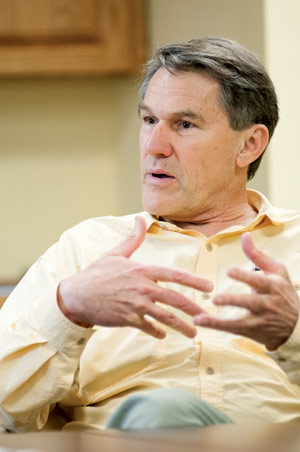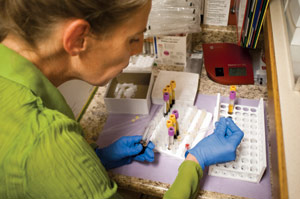LIBBY – It was on the clothes they worked in, the dirt they played in and the homes they lived in. It was Libby amphibole asbestos and it changed this close-knit Montana community forever.
It has been more than a decade since the first reports emerged that hundreds of people around Libby had been sickened by asbestos, found in the vermiculate once mined by W.R. Grace and Company. In the years since, some 2,000 current or former residents have been diagnosed with asbestos-related diseases and at least 400 have died. Libby was declared an Environmental Protection Agency Superfund site in 2002. In June 2009, EPA administrator Lisa Jackson named Libby the agency’s first and only Public Health Emergency resulting from an environmental disaster.
“In Libby, everyone knows someone affected by it,” said Dusti Thompson, outreach coordinator for the Center for Asbestos Related Disease, better known as the CARD Clinic.
In 2013, CARD is marking its 10th year as an independent research and health care facility created specifically to deal with Libby amphibole asbestos. Every year, CARD provides free asbestos health screenings to anyone who lived in the area for at least six months before April 2003. In the past decade, it has screened more than 5,000 people. The center is also leading the science and medical community in research about the unique diseases that stem from the asbestos-laden vermiculite once produced in Lincoln County.
Vermiculite was first found near Libby in 1881 and mining began in the 1920s. The material was used for anything from soil additives to home insulation. According to CARD’s administrative director, Tanis Hernandez, insulation derived from Libby vermiculate was used in 30 million homes across the country.
Shelly Taylor grew up in Lincoln County and now works as a research assistant at CARD. Her grandfather was the first miner to be diagnosed with asbestosis and he died in the 1950s. Taylor says she was most likely exposed to the asbestos as a kid, when it was used at the local baseball field and park.
“It’s a little surreal for me, for Libby to be a huge Superfund site, because it’s not what I envisioned my town would become,” she said. “It hits home for us because all of our families were affected.”
Taylor is one of more than 20 people who work at CARD, under the direction of CEO and medical director Dr. Brad Black. He first arrived in Libby in 1977 to open a pediatric care office. In 1984, he became the county’s health officer and it was in that position he became involved with the asbestos cases.
 |
|
Dr. Brad Black, Chief Executive Officer and Medical Director, talks about his personal history with the Center for Asbestos Related Disease while at the clinic in Libby. – Lido Vizzutti | Flathead Beacon |
In 2000, Black founded CARD as a department of St. John’s Lutheran Hospital. Over the next two years, the department saw more than 7,300 residents as part of an initial screening by the Agency for Toxic Substances and Disease Registry. Using spirometry lung tests and chest X-rays, it was found that the asbestos affected 18 percent of participants. What was especially concerning was that it hadn’t just affected former W.R. Grace employees, but people who had nothing to do with the mine up Rainy Creek, just north of town. Exposure to asbestos can lead to scarring of the lungs and, in some cases, mesothelioma, a cancer of the organ lining.
Looking back on his career, Black said there were many cases of asbestosis that local doctors saw but never identified.
“It’s the most humbling experience of my life,” Black said. “It’s understandable why we missed it, because if you don’t know there is an exposure, it’s not obvious.”
As the EPA began its extensive cleanup of Libby, the CARD staff realized the issues facing it were far greater than a hospital department could handle. On April 1, 2003, it became an independent, nonprofit group dedicated to the treatment and study of asbestos-related diseases. The center is governed by a volunteer board of directors and funded with grants and service fees.
Besides free health screenings, CARD provides respiratory therapy and counseling for the emotional aspects of the disease. Some of the information gathered from patients is used by CARD for research purposes. With patient consent, the data has been shared with research institutes and universities across the country to try to better understand asbestos. Even though scientists and medical professionals have been looking at the issue for more than a decade, Hernandez says there is still much to learn.
“The final verdict of what’s a toxic dose is still unknown,” she said. “(But) for any toxic substance, it’s about dose, duration and frequency.”
Thompson said another job of the CARD Clinic is to inform the public about asbestos-related diseases. These outreach and education programs include attending health fairs and presenting information at local schools. LeRoy Thom, a former W.R. Grace employee and current CARD board member, says the education has helped ease the stigma of asbestos-related diseases, even locally. Thom, who was diagnosed with asbestosis, says some people blame Libby’s hardships on the exposure.
 |
|
Phlebotomist Linda Storkson uses a pipette to transfer samples of blood after centrifugation – separated into plasma, buffy coat and erythrocytes – into small plastic vials while working in her laboratory at the Center for Asbestos Related Disease in Libby. – Lido Vizzutti | Flathead Beacon |
“In the beginning there was resentment about it, but I think as people have gotten educated, they understand it more,” he said.
Education is important, Thom says, because the asbestos issue isn’t going away anytime soon in Libby. Black says the symptoms of asbestos-related diseases take 10 to 40 years to appear. By that math, he estimates there will be cases in Libby for years or even decades to come.
For now, the number of new cases remains steady, but Black says at some point the number should decline.
As the town tries moves forward, Thom and others say some good has emerged from the bad.
“(CARD) has done a lot of good here and it’s helped educate people,” he said. “It’s been a silver lining in this whole problem.”